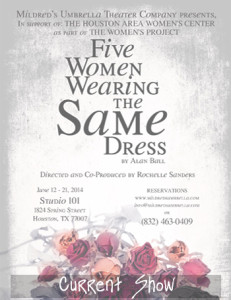June 12, 2014 Mildred’s
There Was a Play That Wasn’t There
June 12, 2014 —There was a play that was played on the stage tonight and there was a play that wasn’t there. There were five beautiful women players playing and there was a Play called “Five Women Wearing The Same Dress”. The players were wearing similar dresses, but I’m not certain that they were the same dress. There was a woman playing ‘simple’ but not in an Amish way. I must wonder if we saw Agit-prop theater which was making a statement about Christianity and Christians by directing this actor to be simple and Christian. There was a woman in the play that wasn’t there who makes the audience and other players be shocked that she is as old as she is but still is a virgin. I can’t imagine that the woman player played simple because that’s how SHE wanted to play a virgin who might not surprise her friends or the audience announcing that she was a virgin because many times simple people’s virginity is protected by the unsimple. Her great timing on some of the jokes and reactions and gag lines makes me believe that she was more likely directed to be simple. Maybe I’m wrong. The choice to be simple flattened expected reactions from her in her first scenes and made me wonder about her acting abilities. She was playing simple. In the play that wasn’t there a character fought a group of discouraged, disheartened, disbelieving women to validate and explicate her faith. The laughs would have flowed like holy water in that play that wasn’t there. The player got good laughs, but they were surprising being so on top of wittiness and still simple.
The founder of 14 Pews Theater was there and, at intermission, she said it was playing like Sex and the City, that she didn’t believe for a second that women would ever talk that way, that she was tired of men, gay or not, writing parts for women that didn’t sound like women. I agree that in the play that wasn’t there, there were stereotypical women figures being used to express not-so-womanly lines. Rather than playing stereotypes, the players often chose stillness and ‘not-doing’. The play that wasn’t there shows characters getting drunker and drunker and more messed up. It talks about stumbling. The players that played may have said “I’ve got to stop stumbling” or something like that but forgot to stumble to cause the line to be said. I saw an actor come onto the set in despair and saying she was having trouble walking because she was so drunk but talking pretty lucidly and walking with balance intact. In the play that wasn’t there, I would imagine a very sloppy scene of stumbling and blubbering and then an increase in the drunkenness as she keeps drinking. I saw the five women players talking and walking like modern women from…..Houston? In the play that wasn’t there I was STUNNED to hear that they lived in Tennessee in the 1990’s. There was a woman who played a redheaded rebel. She was grown and nasal labial marked. How old was the rebel in the play that wasn’t there if she was 12 when her sister got engaged and statutory rape happened? How long was that engagement? 6 years? Was she back from college? She was home again from what? In the play I saw, the redheaded rebel became extremely childlike when confessing her victimhood. It was touching, but was the play that wasn’t there intending a child or a damaged 20 something year old to be consoled by the other women?
I was a bit confused by the choice to have the dueling dialog scene between Tripp and the ‘tramp’ be so far separated then when the words could be parried by touch and smell and sensual probing. Rather than seeing her back for most of that scene, a dance along with close proximity touching could have solved many various blocking and acting problems. Then, when they got scared that they were too close verbally, they came close together physically. I can’t understand why they didn’t, at that time, pull apart physically.
H.R. Bradford as Tripp seemed to be feeling impulses to grab and caress his love interest, but it was like there was a chilly force field keeping him stuck on his mark.
Jennifer Decker as Georgeanne tried hard, but unsuccessfully, to hide her glowing beauty in a sad, drunken, unfulfilled character. Her drunkenness and soberness shifted like waves but she didn’t often move like waves were pushing her off balance.
Elizabeth Keel, as Francis, if that was the abused child, stalked the set stork-like, in the end delivering a babyish character moment that was quite touching.
I couldn’t tell, without pictures in the program, what name fit what character, all of them being somewhat generic, so may I say that the tall redheaded actor had some really nice moments in movement and delivery. She may have, uh, milked the vegetable eating a bit, but she was there, alive on stage most of the time. The ‘tramp’ character was very strong in the first act, giving something to watch in movement and action. She looked like she really got stoned, by subtle transformation. She seemed less defined as Act Two progressed and really seemed stilted and reserved in her interactions with Tripp, not at all a revived, revitalized Inamorata.
You want to see 5 beautiful women close up on stage and one gorgeous guy, go see this production. Don’t worry about the other play. Maybe it would be fun to see that one done by 5 guys in the same dress. yeah.

